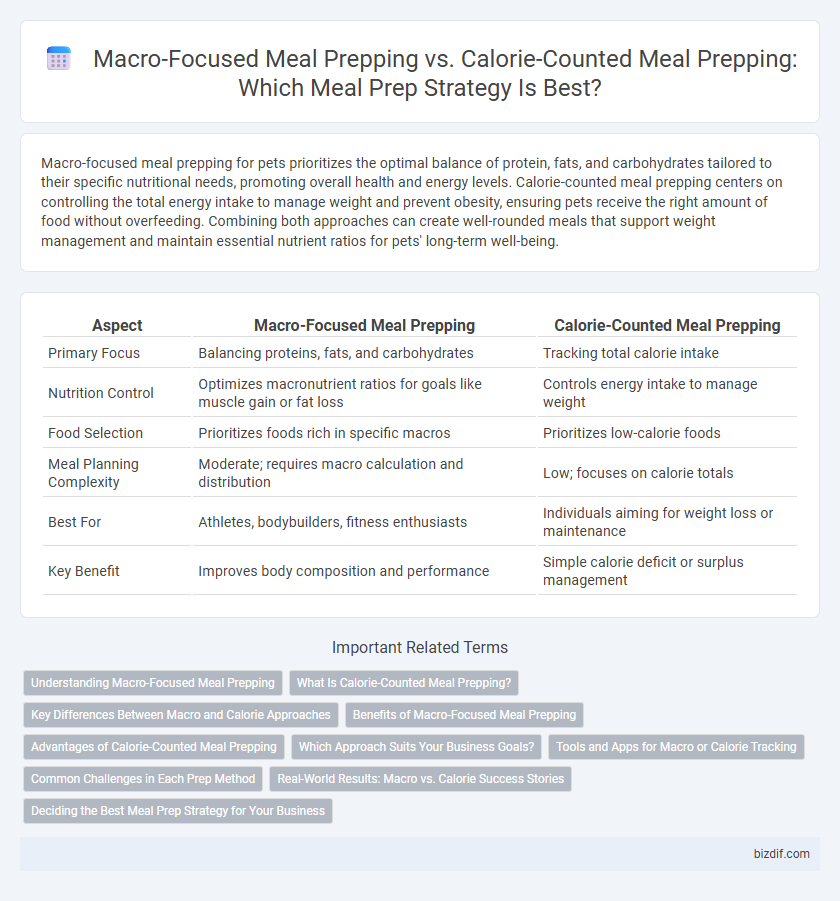Macro-focused meal prepping for pets prioritizes the optimal balance of protein, fats, and carbohydrates tailored to their specific nutritional needs, promoting overall health and energy levels. Calorie-counted meal prepping centers on controlling the total energy intake to manage weight and prevent obesity, ensuring pets receive the right amount of food without overfeeding. Combining both approaches can create well-rounded meals that support weight management and maintain essential nutrient ratios for pets' long-term well-being.
Table of Comparison
| Aspect | Macro-Focused Meal Prepping | Calorie-Counted Meal Prepping |
|---|---|---|
| Primary Focus | Balancing proteins, fats, and carbohydrates | Tracking total calorie intake |
| Nutrition Control | Optimizes macronutrient ratios for goals like muscle gain or fat loss | Controls energy intake to manage weight |
| Food Selection | Prioritizes foods rich in specific macros | Prioritizes low-calorie foods |
| Meal Planning Complexity | Moderate; requires macro calculation and distribution | Low; focuses on calorie totals |
| Best For | Athletes, bodybuilders, fitness enthusiasts | Individuals aiming for weight loss or maintenance |
| Key Benefit | Improves body composition and performance | Simple calorie deficit or surplus management |
Understanding Macro-Focused Meal Prepping
Macro-focused meal prepping emphasizes balancing proteins, carbohydrates, and fats to optimize nutritional intake for fitness and health goals. This approach allows greater flexibility in food choices while ensuring each meal supports muscle growth, energy levels, and metabolic function. Tracking macronutrients rather than just calories leads to more precise adjustments in diet quality and performance outcomes.
What Is Calorie-Counted Meal Prepping?
Calorie-counted meal prepping involves planning and preparing meals based on a specific caloric target to support weight management or fitness goals. This method requires precise measurement of ingredient portions to ensure that each meal contains the intended calorie amount, promoting energy balance. Tracking calories helps individuals regulate intake effectively, making it easier to achieve fat loss, maintenance, or muscle gain based on their dietary objectives.
Key Differences Between Macro and Calorie Approaches
Macro-focused meal prepping emphasizes the precise balance of proteins, carbohydrates, and fats to optimize body composition and performance, while calorie-counted meal prepping primarily targets total energy intake for weight management. The macro approach requires tracking individual nutrient ratios to support specific fitness goals, whereas calorie counting involves monitoring overall calories consumed regardless of nutrient distribution. Understanding these distinctions helps tailor meal plans that either prioritize nutrient quality or overall caloric control for effective dietary outcomes.
Benefits of Macro-Focused Meal Prepping
Macro-focused meal prepping enhances nutritional balance by targeting specific amounts of proteins, carbohydrates, and fats tailored to individual fitness goals, leading to improved muscle growth and energy management. This approach supports metabolic efficiency and body composition regulation more effectively than simple calorie counting. Emphasizing macronutrients helps maintain sustainable eating habits by prioritizing nutrient quality over quantity, promoting long-term health benefits.
Advantages of Calorie-Counted Meal Prepping
Calorie-counted meal prepping offers precise control over daily energy intake, making it easier to achieve specific weight management goals. This approach enables tracking of exact caloric consumption, improving adherence to diet plans through measurable targets. It supports balanced nutrient distribution by aligning calories with individual metabolic needs, enhancing overall dietary discipline and effectiveness.
Which Approach Suits Your Business Goals?
Macro-focused meal prepping targets specific protein, carbohydrate, and fat ratios ideal for muscle gain or fat loss, making it suitable for fitness-centric businesses. Calorie-counted meal prepping emphasizes total daily energy intake to promote weight management, appealing to clients focused on general health or weight control. Choosing the right method depends on your business goals: prioritize macro tracking for performance-driven programs and calorie counting for broader wellness or weight loss services.
Tools and Apps for Macro or Calorie Tracking
Macro-focused meal prepping benefits from apps like MyFitnessPal and Carb Manager that offer detailed breakdowns of protein, fats, and carbohydrates, enabling precise nutrient targeting. Calorie-counted meal prepping often utilizes tools such as Lose It! and Calorie Counter by FatSecret, which emphasize total calorie intake while providing basic macronutrient data. Both approaches integrate barcode scanners and extensive food databases to streamline meal logging and optimize dietary adherence.
Common Challenges in Each Prep Method
Macro-focused meal prepping often faces challenges in accurately balancing protein, carbohydrates, and fats to meet specific fitness goals, requiring careful measurement and ingredient selection. Calorie-counted meal prepping struggles with ensuring nutrient density while staying within strict calorie limits, sometimes leading to monotonous meals and nutrient deficiencies. Both methods demand consistent tracking and planning, which can be time-consuming and difficult to maintain over the long term.
Real-World Results: Macro vs. Calorie Success Stories
Macro-focused meal prepping emphasizes balancing protein, fats, and carbohydrates to optimize body composition and energy levels, often leading to improved muscle gain and fat loss in real-world success stories. Calorie-counted meal prepping prioritizes total energy intake, helping individuals achieve weight loss or maintenance by creating consistent caloric deficits or surpluses. Success stories highlight that macro-focused strategies tend to yield more sustainable results with better body composition, while calorie-counted methods offer simplicity and accessibility for general weight management.
Deciding the Best Meal Prep Strategy for Your Business
Macro-focused meal prepping emphasizes balanced proportions of proteins, fats, and carbohydrates to optimize nutrient intake and support specific fitness goals. Calorie-counted meal prepping centers on total energy intake, ensuring clients meet daily caloric targets for weight management or maintenance. Choosing the best meal prep strategy for your business depends on understanding client preferences and goals, with macro-focused prepping appealing to athletes and fitness enthusiasts, while calorie-counting attracts those aiming for weight control.
Macro-focused meal prepping vs calorie-counted meal prepping Infographic

 bizdif.com
bizdif.com